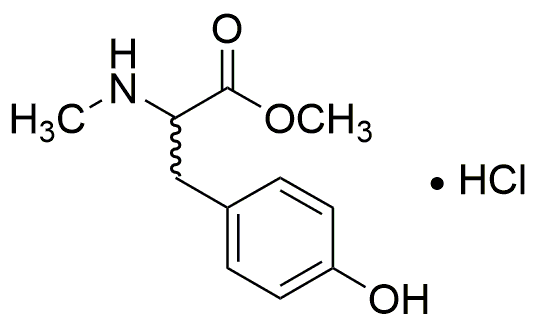N-Methyl-DL-tyrosine methyl ester hydrochloride is widely utilized in research focused on:
- Neuroscience Research: This compound serves as a valuable tool for studying neurotransmitter systems, particularly in understanding dopamine pathways and their implications in various neurological disorders.
- Pharmaceutical Development: It is used in the synthesis of novel pharmaceutical agents, helping researchers design drugs that target specific receptors, enhancing therapeutic efficacy.
- Biochemical Assays: The compound acts as a substrate in enzyme assays, allowing scientists to investigate enzyme kinetics and mechanisms, which is crucial for drug discovery.
- Protein Engineering: It is employed in the modification of proteins to study structure-function relationships, aiding in the development of more effective biopharmaceuticals.
- Metabolic Studies: Researchers utilize this compound to explore metabolic pathways, providing insights into metabolic disorders and potential treatment strategies.
General Information
Properties
Safety and Regulations
Applications
N-Methyl-DL-tyrosine methyl ester hydrochloride is widely utilized in research focused on:
- Neuroscience Research: This compound serves as a valuable tool for studying neurotransmitter systems, particularly in understanding dopamine pathways and their implications in various neurological disorders.
- Pharmaceutical Development: It is used in the synthesis of novel pharmaceutical agents, helping researchers design drugs that target specific receptors, enhancing therapeutic efficacy.
- Biochemical Assays: The compound acts as a substrate in enzyme assays, allowing scientists to investigate enzyme kinetics and mechanisms, which is crucial for drug discovery.
- Protein Engineering: It is employed in the modification of proteins to study structure-function relationships, aiding in the development of more effective biopharmaceuticals.
- Metabolic Studies: Researchers utilize this compound to explore metabolic pathways, providing insights into metabolic disorders and potential treatment strategies.
Documents
Safety Data Sheets (SDS)
The SDS provides comprehensive safety information on handling, storage, and disposal of the product.
Product Specification (PS)
The PS provides a comprehensive breakdown of the product’s properties, including chemical composition, physical state, purity, and storage requirements. It also details acceptable quality ranges and the product's intended applications.
Certificates of Analysis (COA)
Search for Certificates of Analysis (COA) by entering the products Lot Number. Lot and Batch Numbers can be found on a product’s label following the words ‘Lot’ or ‘Batch’.
Número de catálogo
Número de lote/lote
Certificates Of Origin (COO)
This COO confirms the country where the product was manufactured, and also details the materials and components used in it and whether it is derived from natural, synthetic, or other specific sources. This certificate may be required for customs, trade, and regulatory compliance.
Número de catálogo
Número de lote/lote
Safety Data Sheets (SDS)
The SDS provides comprehensive safety information on handling, storage, and disposal of the product.
DownloadProduct Specification (PS)
The PS provides a comprehensive breakdown of the product’s properties, including chemical composition, physical state, purity, and storage requirements. It also details acceptable quality ranges and the product's intended applications.
DownloadCertificates of Analysis (COA)
Search for Certificates of Analysis (COA) by entering the products Lot Number. Lot and Batch Numbers can be found on a product’s label following the words ‘Lot’ or ‘Batch’.
Número de catálogo
Número de lote/lote
Certificates Of Origin (COO)
This COO confirms the country where the product was manufactured, and also details the materials and components used in it and whether it is derived from natural, synthetic, or other specific sources. This certificate may be required for customs, trade, and regulatory compliance.


